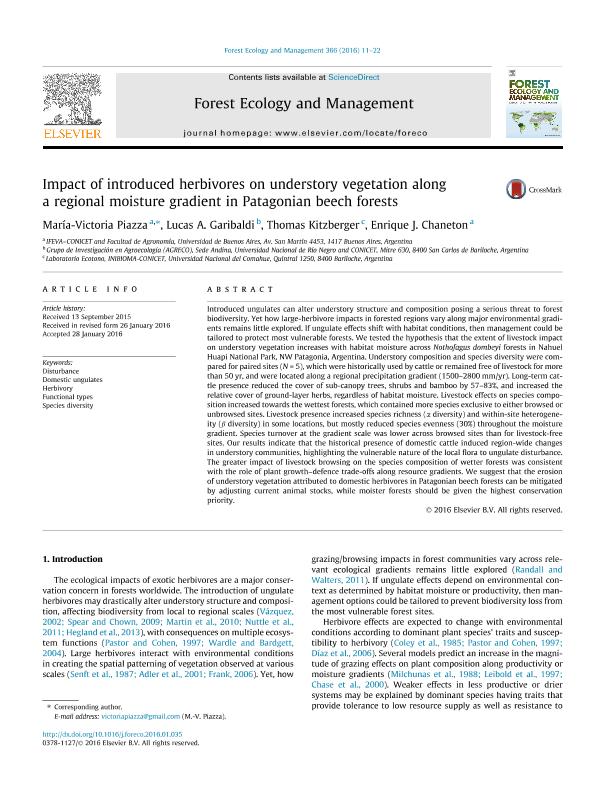Mostrar el registro sencillo del ítem
dc.contributor.author
Piazza, María Victoria

dc.contributor.author
Garibaldi, Lucas Alejandro

dc.contributor.author
Kitzberger, Thomas

dc.contributor.author
Chaneton, Enrique Jose

dc.date.available
2018-07-03T19:33:20Z
dc.date.issued
2016-04
dc.identifier.citation
Piazza, María Victoria; Garibaldi, Lucas Alejandro; Kitzberger, Thomas; Chaneton, Enrique Jose; Impact of introduced herbivores on understory vegetation along a regional moisture gradient in Patagonian beech forests; Elsevier Science; Forest Ecology and Management; 366; 4-2016; 11-22
dc.identifier.issn
0378-1127
dc.identifier.uri
http://hdl.handle.net/11336/51084
dc.description.abstract
Introduced ungulates can alter understory structure and composition posing a serious threat to forest biodiversity. Yet how large-herbivore impacts in forested regions vary along major environmental gradients remains little explored. If ungulate effects shift with habitat conditions, then management could be tailored to protect most vulnerable forests. We tested the hypothesis that the extent of livestock impact on understory vegetation increases with habitat moisture across Nothofagus dombeyi forests in Nahuel Huapi National Park, NW Patagonia, Argentina. Understory composition and species diversity were compared for paired sites (N = 5), which were historically used by cattle or remained free of livestock for more than 50 yr, and were located along a regional precipitation gradient (1500-2800 mm/yr). Long-term cattle presence reduced the cover of sub-canopy trees, shrubs and bamboo by 57-83%, and increased the relative cover of ground-layer herbs, regardless of habitat moisture. Livestock effects on species composition increased towards the wettest forests, which contained more species exclusive to either browsed or unbrowsed sites. Livestock presence increased species richness (α diversity) and within-site heterogeneity (β diversity) in some locations, but mostly reduced species evenness (30%) throughout the moisture gradient. Species turnover at the gradient scale was lower across browsed sites than for livestock-free sites. Our results indicate that the historical presence of domestic cattle induced region-wide changes in understory communities, highlighting the vulnerable nature of the local flora to ungulate disturbance. The greater impact of livestock browsing on the species composition of wetter forests was consistent with the role of plant growth-defence trade-offs along resource gradients. We suggest that the erosion of understory vegetation attributed to domestic herbivores in Patagonian beech forests can be mitigated by adjusting current animal stocks, while moister forests should be given the highest conservation priority.
dc.format
application/pdf
dc.language.iso
eng
dc.publisher
Elsevier Science

dc.rights
info:eu-repo/semantics/openAccess
dc.rights.uri
https://creativecommons.org/licenses/by-nc-sa/2.5/ar/
dc.subject
Disturbance
dc.subject
Domestic Ungulates
dc.subject
Functional Types
dc.subject
Herbivory
dc.subject
Species Diversity
dc.subject.classification
Ecología

dc.subject.classification
Ciencias Biológicas

dc.subject.classification
CIENCIAS NATURALES Y EXACTAS

dc.title
Impact of introduced herbivores on understory vegetation along a regional moisture gradient in Patagonian beech forests
dc.type
info:eu-repo/semantics/article
dc.type
info:ar-repo/semantics/artículo
dc.type
info:eu-repo/semantics/publishedVersion
dc.date.updated
2018-06-22T14:38:58Z
dc.identifier.eissn
1872-7042
dc.journal.volume
366
dc.journal.pagination
11-22
dc.journal.pais
Países Bajos

dc.journal.ciudad
Amsterdam
dc.description.fil
Fil: Piazza, María Victoria. Consejo Nacional de Investigaciones Científicas y Técnicas. Oficina de Coordinación Administrativa Parque Centenario. Instituto de Investigaciones Fisiológicas y Ecológicas Vinculadas a la Agricultura. Universidad de Buenos Aires. Facultad de Agronomía. Instituto de Investigaciones Fisiológicas y Ecológicas Vinculadas a la Agricultura; Argentina
dc.description.fil
Fil: Garibaldi, Lucas Alejandro. Consejo Nacional de Investigaciones Científicas y Técnicas. Centro Científico Tecnológico Conicet - Patagonia Norte; Argentina. Universidad Nacional de Rio Negro. Sede Andina; Argentina
dc.description.fil
Fil: Kitzberger, Thomas. Consejo Nacional de Investigaciones Científicas y Técnicas. Centro Científico Tecnológico Conicet - Patagonia Norte. Instituto de Investigaciones en Biodiversidad y Medioambiente. Universidad Nacional del Comahue. Centro Regional Universidad Bariloche. Instituto de Investigaciones en Biodiversidad y Medioambiente; Argentina
dc.description.fil
Fil: Chaneton, Enrique Jose. Consejo Nacional de Investigaciones Científicas y Técnicas. Oficina de Coordinación Administrativa Parque Centenario. Instituto de Investigaciones Fisiológicas y Ecológicas Vinculadas a la Agricultura. Universidad de Buenos Aires. Facultad de Agronomía. Instituto de Investigaciones Fisiológicas y Ecológicas Vinculadas a la Agricultura; Argentina
dc.journal.title
Forest Ecology and Management

dc.relation.alternativeid
info:eu-repo/semantics/altIdentifier/url/http://www.sciencedirect.com/science/article/pii/S0378112716300019
dc.relation.alternativeid
info:eu-repo/semantics/altIdentifier/doi/http://dx.doi.org/10.1016/j.foreco.2016.01.035
Archivos asociados
